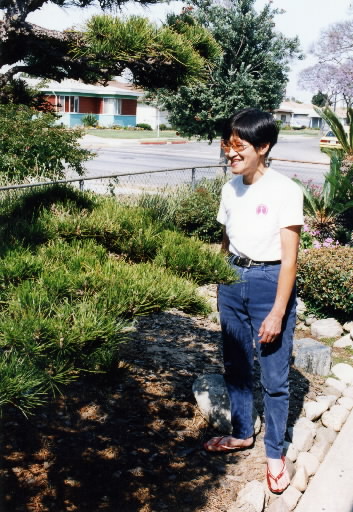Hiroshima Girls, Part 3: Half a Century After the Bombing [3]
Jul. 3, 2010
Faith supports mother of four in longed-for nation
by Masami Nishimoto, Staff Writer
This feature series on the "Hiroshima Girls," also known as "Hiroshima Maidens," is a close look at a number of Japanese women who were impacted by the atomic bombing of Hiroshima. The series was originally published in 1996.
Mitsuko Sakamoto, 60, whose maiden name is Kuramoto, stayed in the United States and married after undergoing medical treatment there. When I visited her home, she readily invited me inside, asking, "How is everyone in Hiroshima?"
The city of Gardena, population 48,000, is roughly a 30-minute drive south on the highway from central Los Angeles. An increasing number of Asian migrants work for the factories sprouting in this area, where farms run by people Japanese descent once lay. Trimmed pine trees and mandarin orange trees color Ms. Sakamoto's yard.
"When I was in Hiroshima, I prayed to God every morning and evening: 'Please let me go to the United States.' I was overjoyed when I found out, through the radio, the names of those going to the United States for treatment."
Ms. Sakamoto paused and picked up a tissue. She said that the clogged lachrymal gland in her right eye caused it to water. After wiping her eye, she began to speak again in calm tones. "I was a third grader at Oshiba Elementary School at the time of the atomic bombing," she said.
When the bomb exploded, she was in a classroom at Oshiba Elementary School. The school was located in Nishi Ward, about 2.5 kilometers from the hypocenter. Her right eye was pierced by glass fragments and had to be removed. As she could not stand being stared at on the street, she wore an eye patch to conceal her artificial eye, made of glass. However, the glass eye was so heavy that it caused her body sharp pain. Since she was a teenager, she had dreamt of traveling to the United States, where, she heard, there were artificial eyes made of plastic.
At Mount Sinai Hospital in New York City, where she underwent plastic surgery, a technician fitted her with the plastic eye she had desired. Her host family bought her a pair of sunglasses and arranged for her to attend a local high school. Their strong encouragement, expressed not only in words but also accompanied by action, went straight to her heart.
"I thought I would be so happy if I could live in such a country," she recalled. "One of my mother's relatives was living in Los Angeles then and she introduced me to my husband." As a result, she did not return to Hiroshima, instead registering her marriage in the U.S. state of Nevada, next to California, in September 1956. At the time it was not easy for Japanese nationals to marry and live permanently in California.
Frank Sakamoto, her late husband, was a second-generation Japanese-American, whose parents were from Hiroshima. He was a former soldier of the 442nd infantry, a Japanese-American unit, which, with the motto "Go for broke," fought on fierce battlefields at various locations in Europe. Frank volunteered for the military service from an internment camp in Arkansas, the state which later produced President Bill Clinton. After his discharge from military service, he became engaged in a gardening business.
Ms. Sakamoto turned the pages of a family album and looked back on the past: "He consoled me, saying, 'I have a scar on my right leg from the time I was shot in Italy.' He was a kind, understanding person." After a six-year battle with cancer, Frank died last May at the age of 73. "We tried every available treatment. We were even ready to sell the house, but…"
Now that she has come to terms with the loss, Ms. Sakamoto is looking for work. Though she has four children, she wants to test her strength while she is in good health. "I'm praying to Jesus," she continued calmly. "I think my wish will surely be granted."
Her faith, above all, provides her with inner strength. She was baptized 33 years ago, when she obtained U.S. citizenship. She smiled and said that after her younger son and younger daughter become independent, she would like to go to Brazil to help her husband's cousin, who has been engaged in missionary work there.
"I'm praying for the happiness of those who returned to Hiroshima and for a peaceful world without war. Please be sure to tell them this," she said.
With these words, Ms. Sakamoto handed me gifts for Hatsuko Yokoyama, 87, a resident of Nishi Ward, Hiroshima, and Tomin Harada, 84, a doctor and resident of Naka Ward, Hiroshima, both of whom provided support for the A-bomb survivors while visiting the United States for medical treatment. In spite of her A-bomb experience, Ms. Sakamoto has never obtained the Atomic Bomb Survivor's Certificate. She has no medical insurance in the United States, either. Still, Ms. Sakamoto said quietly, with conviction: "I'm thankful for everything."
(Originally published on July 28, 1996)








